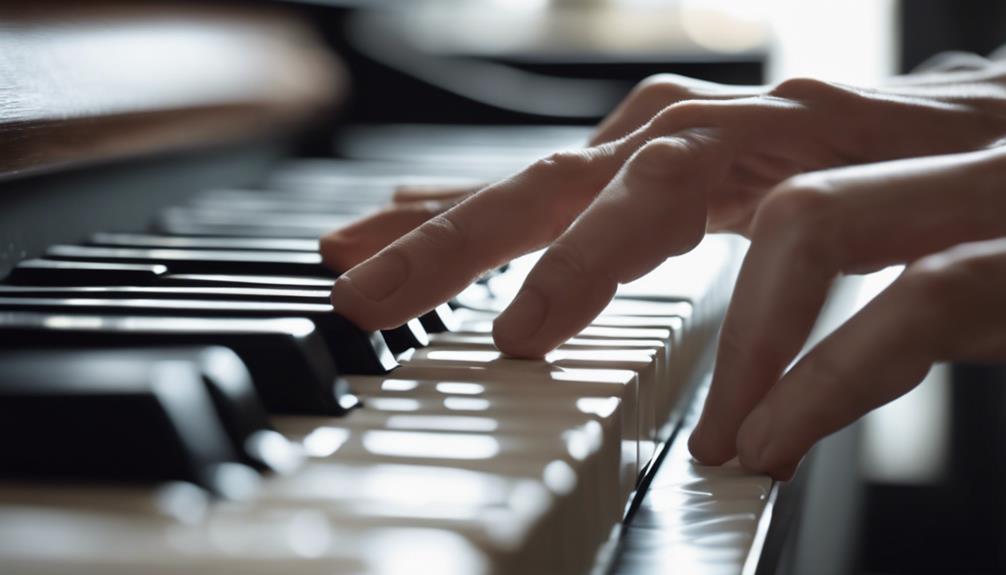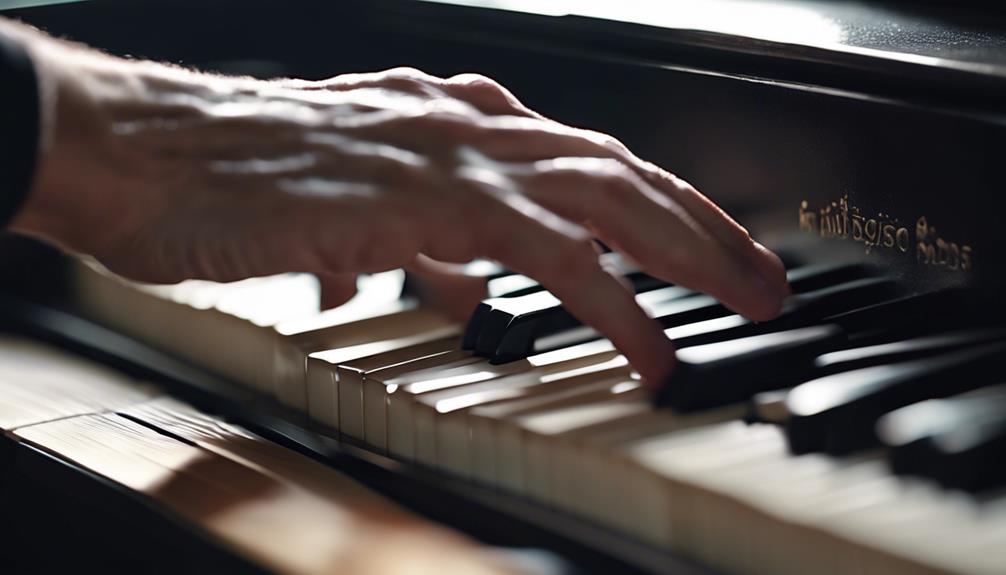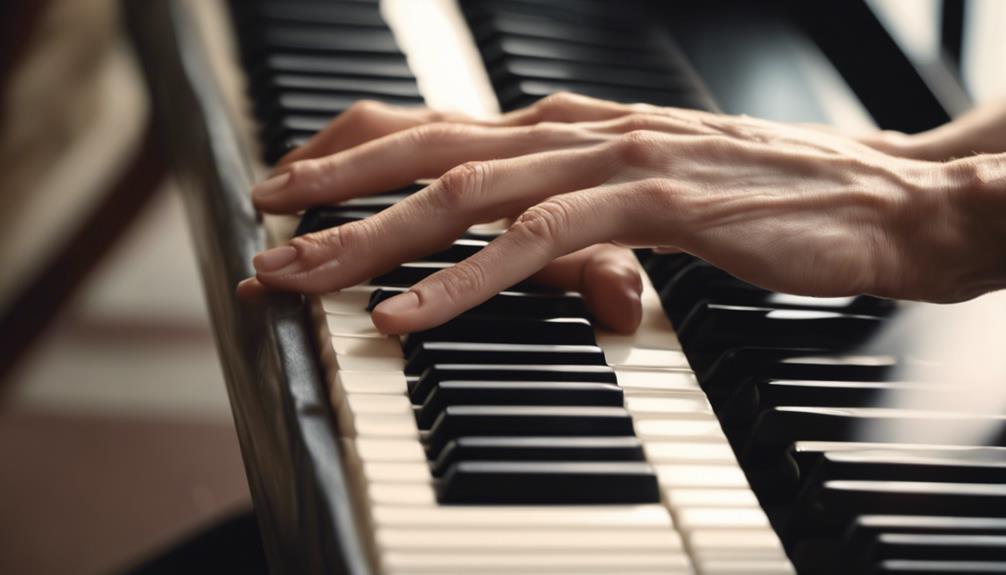Improving your finger strength for piano playing isn’t just about brute force; it’s a blend of technique, consistency, and specific exercises.
Warm-up routines, proper hand positioning, and dedicated finger drills can make a significant difference. You might be surprised by how effective scales and arpeggios are when practiced regularly. But that’s just the beginning.
Have you considered how finger lifting and wrist extensions contribute to your overall performance? These elements can elevate your playing to new heights, but there’s more to explore. What other methods can enhance your finger agility and prevent injuries?
TL-DR
- Incorporate daily finger drills like arpeggios, trills, and chromatic exercises to build strength and agility.
- Practice scales and arpeggios with proper finger placement to enhance muscle memory and coordination.
- Utilize targeted finger exercises, focusing on weaker fingers to ensure balanced strength across all fingers.
- Begin warm-up routines with finger taps, lifts, and stretches to improve flexibility and prevent injuries.
- Gradually increase tempo in exercises with a metronome to track progress and develop speed and precision.
Importance of Finger Strength

Strong fingers are essential for playing the piano with speed, accuracy, and expressive control. When you improve your finger strength, you gain the ability to play challenging pieces with greater precision and fluidity. Finger exercises are essential in developing this strength, as they help build the necessary muscles and dexterity.
Improving your finger strength not only enhances your technical abilities but also prevents injuries. Playing the piano for extended periods can strain your hands and fingers if they aren’t adequately conditioned. Regular finger exercises can fortify these muscles, leading to better endurance and reducing the risk of overuse injuries.
Moreover, strong fingers contribute to better hand independence. This is particularly important when tackling complex passages that require your hands to move independently of one another. Improved finger strength allows for smoother shifts and more accurate execution of intricate sections.
As you work on building your finger strength, you’ll notice a significant improvement in your overall technique. This enhanced technique enables you to explore more advanced repertoire, pushing your piano skills to new heights. So, make finger exercises a part of your daily practice to reap these benefits and elevate your playing.
Warm-Up Techniques
To maximize the benefits of finger strength, it’s important to incorporate effective warm-up techniques into your practice routine. Warm-up exercises before playing the piano help prevent injuries and prepare your fingers for practice. Begin with simple finger exercises like finger taps and finger lifts. These exercises gradually build finger strength and are easy to incorporate into your warm-up routine.
Next, add hand stretches and wrist rotations. These moves improve flexibility and help prevent strain, allowing you to play longer without discomfort. Including scales and arpeggios as part of your warm-up routine is also essential. They enhance finger agility and coordination, making your fingers more responsive and accurate during more complex pieces.
Consistent warm-up techniques are key to improving your overall performance. By dedicating a few minutes to warming up, you’re not only strengthening your fingers but also setting a solid foundation for more advanced practice.
Hand Positioning

To enhance your finger strength for piano playing, focus on proper hand positioning. Guarantee your wrists are level and your fingers are curved to promote efficient movement.
This technique, combined with consistent practice, will help you develop the muscle memory needed for fluid and controlled playing.
Correct Wrist Alignment
Why is proper wrist alignment essential for effective piano playing?
Getting your wrist alignment right guarantees a straight line from your forearm to your knuckles, which is vital for both finger and hand efficiency. When your wrists are level with the piano keys and you avoid excessive bending or arching, you prevent unnecessary strain and injury. This promotes fluid, efficient playing, allowing your fingers to move freely and with greater strength.
Incorrect wrist alignment can cause several issues:
- Tension: You’ll feel tightness in your hands and forearms, making it difficult to play smoothly.
- Limited Range of Motion: Bending your wrists too much restricts your hand’s ability to move across the keys.
- Decreased Finger Strength: Improper alignment hampers the development of finger strength, limiting your playing potential.
To maintain proper wrist alignment, focus on keeping your wrists straight and relaxed during practice sessions. Consistent attention to this detail enhances your overall technique and finger strength development.
Finger Curvature Technique
After mastering proper wrist alignment, focus on maintaining a natural curvature in your fingers to guarantee optimal hand positioning and finger strength. When playing the piano, your fingers should be rounded and relaxed, avoiding any excessive tension. This natural curvature not only enhances finger strength but also promotes better control and agility.
Think of your fingers as mirroring the shape of the piano keys. By doing so, you’ll secure fluid and effortless movement across the keyboard. Consistent practice with this correct finger curvature can prevent strain and improve your technique over time. This foundation is essential for tackling intricate pieces with ease and precision.
To develop strong finger alignment and curvature, pay close attention to how your fingers interact with the keys. Regularly check that your fingers remain curved and relaxed, especially during challenging passages. This habit will help you build a solid technique and enhance your overall performance quality.
Finger Drills
Finger drills are essential for developing the finger strength and agility needed for proficient piano playing. These exercises focus on repetitive movements to target specific finger muscles, enhancing your dexterity and coordination. By practicing finger drills regularly, you’ll build muscle memory, improve your speed, and increase finger independence.
To keep your practice sessions engaging and effective, try incorporating a variety of drills into your routine:
- Arpeggios: These exercises help you practice smooth shifts between non-adjacent notes, enhancing finger coordination.
- Trills: Rapid alternation between two adjacent notes will boost your finger speed and agility.
- Chromatic exercises: Playing every note in a sequence helps improve finger strength and uniformity in movement.
Incorporating these drills consistently will lead to noticeable improvements in your overall piano performance. Variations like scales, arpeggios, trills, and chromatic exercises all work on different aspects of your technique, ensuring thorough development.
Scales Practice

Practicing scales like C Major and G Major is crucial for developing finger strength and independence on the piano. By dedicating time to scales practice, you’ll notice improvements in finger speed, control, and accuracy. Start with simpler scales and gradually increase the difficulty by adding more complex ones to your routine.
When you practice scales, focus on proper finger placement and hand position. This guarantees that you’re building the right kind of muscle memory and avoiding unnecessary strain. Consistent practice of scales helps break down the mechanics of finger movements, reinforcing the strength needed for more intricate pieces.
Don’t rush your practice. Begin at a comfortable tempo and gradually increase the speed as you gain confidence. This approach ensures that you maintain accuracy while building finger strength. Remember, quality practice is more effective than quantity.
Incorporate a variety of scales into your sessions to challenge different finger patterns and movements. This variety not only boosts finger strength but also enhances your overall playing technique. With regular scales practice, you’ll find that your fingers become more agile and responsive, making complex pieces easier to tackle.
Arpeggios Practice
To enhance your finger strength and agility, practicing arpeggios is essential. Arpeggios involve playing the notes of a chord sequentially, which helps you develop finger independence and control. By practicing arpeggios in various keys, you not only challenge your fingers but also build strength and dexterity.
Here are a few reasons why arpeggios should be part of your daily practice:
- Finger Independence: Arpeggios help you move each finger independently, important for playing complex pieces.
- Coordination: Different arpeggio patterns improve your coordination and muscle memory, leading to smoother playing.
- Versatility: Practicing in various keys ensures you’re comfortable with different fingerings and hand positions.
Start with simple major and minor arpeggios and gradually move to more complex ones. Pay attention to your finger placement and make sure each note is played cleanly. Practicing arpeggios slowly at first can help you focus on accuracy and build the necessary strength. As you get more comfortable, increase the tempo to improve your agility.
Regular arpeggio practice will lead to more controlled and confident piano playing. So, incorporate arpeggios into your routine to see significant improvements in your finger strength and overall technique.
Hanon Exercises

While arpeggios build a solid foundation for finger strength and dexterity, Hanon exercises take this to the next level by focusing on specific technical challenges. These renowned piano exercises are designed to improve finger strength, speed, and dexterity by addressing issues like uneven finger strength and lack of control.
Hanon’s book, *The Virtuoso Pianist in Exercises*, is structured to develop finger independence and control. The exercises involve repetitive patterns that require each finger to work individually, which is essential for achieving greater finger agility and accuracy. By practicing these exercises daily, you can notably enhance your overall piano technique.
Many piano teachers recommend incorporating Hanon exercises into your practice routine. Consistent practice helps you build the necessary strength and flexibility in your fingers, allowing you to tackle more complex pieces with ease.
The repetitive nature of these exercises ensures that you focus on each finger’s movement, leading to improved finger strength over time.
Incorporating Hanon exercises into your daily routine will help you achieve a higher level of proficiency on the piano. Regular practice of these targeted piano exercises won’t only improve finger strength but also enhance your control and independence, making you a more skilled and confident pianist.
Speed Exercises
Speed exercises are essential for developing the finger agility and control needed to play fast-paced piano pieces with precision. By incorporating speed exercises into your practice routine, you’ll not only build finger strength but also enhance your overall playing technique. Start by focusing on scales and arpeggios, playing them at a gradually increasing tempo. This method will challenge your fingers to move quickly and accurately.
Consider these key tips to make the most of your speed exercises:
- Start Slow: Begin at a comfortable tempo and gradually increase the speed to avoid mistakes and build confidence.
- Use a Metronome: This helps you maintain a steady tempo and track your progress as you increase speed.
- Practice in Short Bursts: Focus on short, challenging passages to prevent fatigue and improve finger dexterity.
Challenging yourself with pieces that require quick finger movements can notably enhance your overall playing speed. As you practice difficult passages, you’ll notice an increase in finger strength and dexterity.
Agility Drills

Building on the foundation of speed exercises, agility drills further enhance your finger speed, coordination, and flexibility for piano playing. By incorporating agility drills into your practice routine, you’ll greatly boost your finger strength and control, which are vital for tackling advanced piano pieces.
Start with scales and arpeggios, increasing the tempo gradually. This not only sharpens your finger speed but also improves your coordination and precision. The key is to maintain accuracy even as the tempo climbs. Avoid rushing; it’s better to play slowly and correctly than fast and sloppy.
Next, tackle challenging passages from your repertoire. Isolate difficult sections and practice them repeatedly at varying speeds. This helps build muscle memory and dexterity in your fingers. Remember, consistency is essential. Regular practice of these drills will solidify your technique over time.
Agility drills are more than just speed exercises; they’re about achieving fluidity and effortless movement across the keys. With persistence, you’ll notice a considerable improvement in your overall playing technique. Keep pushing yourself, and you’ll develop the finger strength and agility needed to master even the most intricate compositions.
Stretching Exercises
Stretching exercises are essential for preventing injuries and enhancing finger flexibility, making your piano practice more effective and enjoyable. Regularly incorporating these exercises will help you improve dexterity and maintain overall finger health.
To start, try incorporating wrist and forearm stretches before you hit the keys. These stretches will help increase finger mobility and reduce tension, allowing for smoother and more agile playing.
Consider incorporating yoga poses that target your fingers, wrists, and forearms. Poses like ‘Downward Dog’ and ‘Cat-Cow’ are particularly advantageous. They not only stretch your fingers but also provide a thorough stretch for your entire upper body, which is vital for a pianist.
Here are some quick stretching exercises to include in your routine:
- Finger Pulls: Gently pull each finger back towards your wrist, holding for a few seconds.
- Wrist Circles: Rotate your wrists slowly in circles to loosen up the joints.
- Finger Taps: Tap each finger against your thumb, one at a time, to warm up.
Thumb Strengthening

When you’re aiming to improve your piano skills, incorporating thumb strengthening exercises is essential for boosting your hand dexterity and control. Start by straightening your hand with fingers close together and curve your thumb into a C shape. This position targets the thumb specifically, helping to build muscle strength that’s vital for playing the piano efficiently.
Hold the thumb in the C shape for 1-2 seconds before gently releasing and returning to the starting position. This brief but effective hold enhances the muscle engagement necessary for thumb strengthening. Repeat this exercise five times for each hand.
By consistently doing this, you can improve your thumb’s strength and endurance, which translates to better hand stability and precision on the piano keys.
Incorporating these thumb strengthening exercises into your routine can significantly impact your overall hand dexterity. Stronger thumbs allow for more fluid movement and control, enabling you to tackle more complex pieces with ease.
Plus, it helps prevent strain and fatigue, allowing you to practice longer and more effectively. So, make thumb strengthening a regular part of your practice to see tangible improvements in your piano playing abilities.
Finger Lifting
To boost your piano skills, start with isolated finger lifts to target each finger individually.
Next, incorporate finger independence drills to enhance coordination and control.
Isolated Finger Lifts
Isolated finger lifts can greatly enhance your finger strength and independence, essential for mastering complicated piano pieces. By focusing on lifting and lowering each finger separately, you target specific weaknesses and build overall finger strength.
Here’s how to do it: place your hand flat on a table or piano keys and gently lift one finger at a time while keeping the others down. This exercise helps improve finger independence and control, vital for playing intricate piano passages.
Regularly practicing isolated finger lifts offers several benefits:
- Enhanced Dexterity: Strengthening each finger individually boosts your overall agility when playing piano.
- Improved Coordination: These exercises help synchronize your fingers, making shifts between notes smoother.
- Targeted Strength Building: You can focus on weaker fingers, ensuring balanced strength across all fingers.
Incorporating finger lifting exercises into your daily practice routine can lead to noticeable improvements. Consistency is key—doing these exercises a few minutes each day will gradually enhance your finger strength and coordination.
Finger Independence Drills
Finger independence drills, such as finger lifting, are essential for developing the strength and control needed for advanced piano playing. By focusing on lifting each finger one at a time, you can greatly enhance your finger independence and dexterity. This simple yet effective exercise helps pianists improve finger strength, allowing for more precise and controlled playing.
To perform finger lifting exercises, place your hand flat on a surface, such as a table or your piano keys. Gently lift each finger one at a time while keeping the other fingers relaxed and still. This drill might seem easy at first, but it requires concentration and practice to lift each finger smoothly and independently.
Regularly repeating finger lifting exercises will help you develop individual finger strength and coordination. Over time, you’ll find that your fingers feel less weak or uncoordinated during performances, making complex pieces easier to play. Incorporating these drills into your daily practice routine can gradually increase both finger strength and agility, leading to a noticeable improvement in your overall piano technique.
Don’t underestimate the power of consistent practice. By dedicating time to finger lifting exercises, you’re investing in your ability to perform more challenging music with ease and confidence.
Progressive Weight Training
Over time, you can enhance the effectiveness of finger lifting exercises by incorporating progressive weight training. Finger lifting, a great exercise, involves gently lifting each finger one at a time to target and strengthen individual finger muscles. By gradually adding small weights, such as mini resistance bands or finger weights, you can further strengthen your fingers and improve their endurance.
To get started with progressive weight training in your finger lifting routine, consider these steps:
- Mini Resistance Bands: Wrap mini resistance bands around your fingers. These bands provide extra resistance, making your muscles work harder.
- Finger Weights: Use specially designed finger weights that slide onto your fingers. These add a small amount of weight, increasing the intensity of the exercise.
- Weighted Gloves: Try wearing weighted gloves during your finger lifting exercises. The gloves distribute weight evenly across your hands and fingers, enhancing muscle engagement.
Incorporating these tools into your daily practice routine can lead to noticeable improvements in finger strength and agility. With consistent practice, you’ll gain better finger dexterity, control, and independence, essential for achieving superior piano performance.
Progressive weight training through finger lifting is a simple yet highly effective way to make sure your fingers are strong and ready for any piece.
Wrist Extensions

To enhance your piano playing, regularly performing wrist extensions can greatly improve flexibility and strength in your wrists. By integrating wrist extensions into your routine, you can effectively increase your range of motion, allowing your fingers for piano to move more freely and comfortably over the keys.
Wrist extensions involve bending your wrist back and forth. This simple exercise is powerful in preventing wrist injuries and promoting better hand positioning while playing. It’s important to maintain a relaxed hand and wrist during this exercise to avoid strain or discomfort.
Start by gently extending your wrist in one direction, holding for a few seconds, then switch to the opposite direction. Repeat this several times, ensuring that your movements are smooth and controlled.
Incorporating wrist extensions into your warm-up routine can greatly enhance your overall finger agility and playing technique. These exercises help reduce tension in your wrists, making it easier for you to execute complex passages and shifts. Consistent practice will lead to stronger, more flexible wrists, which are essential for mastering the piano.
Legato and Staccato
To improve your finger strength, focus on mastering legato for smooth shifts and staccato for crisp note execution. Practicing these techniques will enhance your finger control and versatility.
This combination not only strengthens your fingers but also enriches your musical expression.
Smooth Transition Techniques
Mastering smooth connection techniques like legato and staccato is essential for enhancing your piano playing’s expressiveness and control. When you’re playing the piano, being able to shift smoothly between these two techniques can greatly improve your overall piano technique.
To practice legato, focus on connecting notes seamlessly with your fingers. Use the pedal to sustain the sound, ensuring each note flows into the next without any breaks.
On the other hand, staccato requires a different approach. Here, you need to execute quick finger movements and lift your fingers off the keys immediately after playing each note, creating a crisp, detached sound.
Here’s why smooth shifts between legato and staccato matter:
- Enhanced Articulation: Achieving clear distinctions between smooth and detached notes makes your playing more expressive.
- Finger Control: Practicing these techniques strengthens finger muscles, leading to better control and dexterity.
- Overall Expression: Combining legato and staccato effectively adds emotional depth to your performances.
Crisp Note Execution
Achieving crisp note execution in both legato and staccato relies on precise finger control and intentional practice. To master legato, focus on connecting notes smoothly with controlled finger movements. Ensure each finger shifts seamlessly to the next key, maintaining a fluid sound. This technique demands finger strength and independence, so practice scales and arpeggios slowly, paying close attention to how each note links.
For staccato execution, aim for short, distinct notes played with quick finger action. Lift your fingers sharply off the keys to achieve a crisp, detached sound. This requires finger strength and agility. Practicing staccato passages with a metronome can help guarantee your timing and precision are consistent, which is essential for a clean execution.
Experimenting with different touches and pressures on the keys can further refine your legato and staccato. By varying your attack and release, you’ll discover the nuances that make each note stand out.
Regularly practicing these techniques won’t only enhance your playing but also build the finger strength necessary for more advanced pieces. Remember, achieving crisp note execution is a blend of control, strength, and mindful practice.
Challenging Pieces

Tackling challenging pieces with fast, intricate sections will greatly enhance your finger strength and agility. When you choose demanding compositions, you push the boundaries of your piano playing skills and develop finger strength more effectively.
Focus on passages that require quick and precise finger motions, and you’ll notice a significant improvement in your control and speed.
To get the most out of practicing challenging pieces, follow these tips:
- Break Down Difficult Sections: Isolate and practice the toughest parts of a piece to make certain each finger movement is accurate and deliberate.
- Slow Practice: Start playing slowly to master the finger positions and movements, gradually increasing the tempo as you gain confidence.
- Consistent Repetition: Regularly practice the intricate sections to build muscle memory and enhance finger agility.
Mastering complex compositions isn’t just about hitting the right notes; it’s about enjoying the process and embracing the challenge. By consistently working on these demanding pieces, you’ll slowly but surely develop the finger strength necessary for advanced piano playing.
Next up, learn all about piano arpeggios in this guide.
